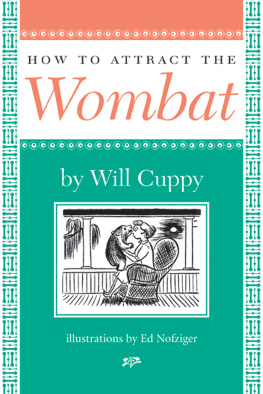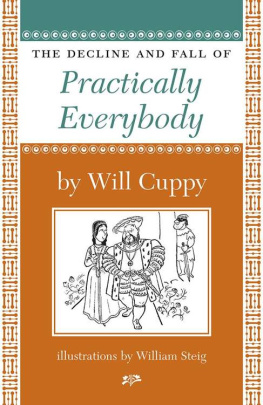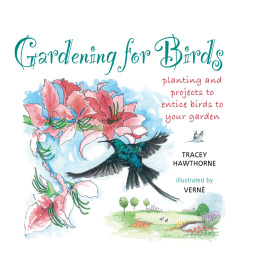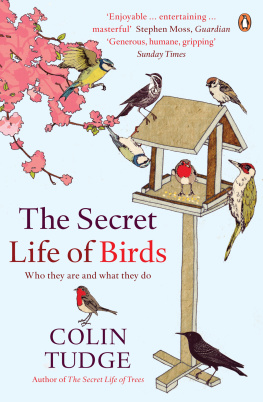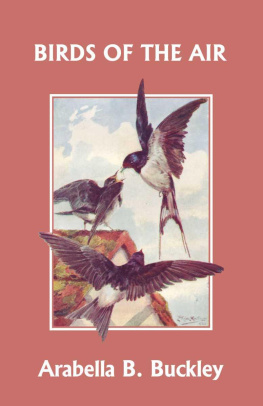

For Marione
This is a Nonpareil Book, first published in 2001 by
DAVID R. GODINE Publisher
Post Office Box 450
Jaffrey, New Hampshire, 03542
www.godine.com
Copyright 2001 by Phyllis Feldkamp
All rights reserved.
No part of this book may be used or reproduced in any manner whatsoever without written permission, except in the case of brief excerpts embodied in critical articles and reviews.
For permission to use all the short animal pieces and two others which appear here in longer versions the author thanks the Saturday Evening Post. Swan-upping, Indeed! was first printed in The New Yorker. Certain other articles of particular interest to Wombat enthusiasts were written especially for this book.
LIBRARY OF CONGRESS
CATALOGING-IN-PUBLICATION DATA
Cuppy, Will, 18841949
How to attract the wombat / by Will Cuppy ;
illustrations by Ed Nofziger
p. cm. (Nonpareil books ; 93)
Originally pulished: New York : Rinehart, 1949
ISBN 1567921566 (softcover : alk. paper)
Ebook ISBN 978-1-56792-575-3
1. American wit and humor. I. Title: Wombat.
II. Nofziger, Ed. III. Title.
IV. Nonpareil book ; 93.
PN6161.C789 2000
814'.52dc21 00061714
CONTENTS


ARE WOMBATS PEOPLE?
It would appear, from the record, that I have written my third animal book. How to Tell Your Friends from the Apes was published in 1931, How to Become Extinct in 1941. Perhaps I should have waited until 1951 before offering How to Attract the Wombat, just to make the dates come out even, but I felt I had things to say about the Wombat which needed to be said at this time.
This volume completes, at least in part, a project conceived some twenty years ago, when I first thought of writing a series of How books which should deal with various aspects of the animal world that particularly interested me, and at the same time rescue me from a rather sordid economic situation, leaving me free for certain other activities I had in mind, such as batting around and having a little fun in my old age. Well, life is like that.
As for this third attempt, the public in general may of course decide that Ive already done enough for the animals. This nasty thought occurred to me the other day on the street when an old friend came along and inquired, Are you still writing those little animals? I was particularly struck, and not favorably, by this question because I have written about some of the largest animals in existence. I do think the elephant should be big enough for anybody, and how about the Sulphur-bottom Whale, the largest animal in the seven seas, sometimes reaching a length of a hundred feet and weighing up to a hundred and fifty tons? What more does he expect?
Im only fooling, for I know well enough that the fellow meant to ask, Are you still writing those little pieces about animals? I should have replied, as I usually do: Yes, I am still writing little pieces about animals. I am a person who writes little pieces about animals. I am in that business. That is what I do. See? I didnt care to make the effort again. I merely nodded noncommittally and walked away, with the curt remark, Nice seeing you again.
I knew so well what the fellow was leading up to, and there are times when I cant take it. In another ten seconds, or make it five, he would have asked, Why dont you write about people, Will? They always do. They have, through the years. They will, as long as I am spared. It is a cross I must bear.
To give you an idea, the first friend I met on the street after writing that book on Apes fought her way through the crowd as soon as she saw me and shouted from afar, Why dont you write about people, Will? This surprised me the more since I had used that very lady as the model for my article on the Chimp in that volume. I was afraid she would sue, but, as seems to be routine with my works, nothing happened. In How to Attract the Wombat she appears again as the main character in my chapter on the Goose, but she will never know it. She thinks I am not interested in people.
Was it for this, I often ask myself, that I have risked my scientific reputation time after time by an outrageously anthropomorphic treatment of the animals, that I have played fast and loose with the accepted distinctions between instinct and intelligence to the point of endangering some of the fundamental principles of Darwin himself, until I probably couldnt get the most menial job in a respectable Zoo?
Why do you suppose I did that unless it was to get in all those dirty cracks about the human race, a form of life I suppose I am a little too much inclined to look down upon. By the way, I must try to get over that or my views will become distorted in time. Not interested in people, indeed!
But they mean well, bless them. They want me to get ahead. They bring me examples of authors, from dim antiquity to this mornings papers, who have risen by easy stages or even jumped instantaneously to the top of their profession by writing about people. Some of these friends have done well in their chosen fields of endeavor. A few of them have what it takes, and God knows they hang on to it. Maybe I should listen to their advice.
Maybe, in response to what I can only regard as public demand, I should write a book about people plainly labeled and certified as such, so that there could be no possible mistake. Then they could ask me, Why dont you write about animals, Will? It would be a change.
And now a word on the Wombat. What is it? Animal, vegetable, or mineral? Give up? I feel justified in asking these forthright questions because the ignorance that prevails on the subject is simply frightening. I know nothing about the Wombat except that it lays eggs and barks, said a lady on whom I was counting for useful information. And when I asked a man whom I had always supposed to be fairly civilized if he had ever heard of the Wombat, he replied, Sure, he played third base on the Yankees in 35. Ninety-nine others merely said No. Really, I sometimes wonder what is the use.
For reasons of my own, I am not telling at this point exactly what a Wombat is or is not. I assure you, though, that the Wombat exists. In the Wombat we are confronted by a fact, not a theory. That is all I care to divulge at the moment as I prefer, in the interest of suspense, to keep the reader on tenterhooks until he comes to the article entitled The Wombat under the larger heading, Problem Mammals.
There, Ive gone and dropped a hint that gives part of the secret away. So the Wombat is a mammal! If I know my public, however, no great harm has been done, for I find the widest divergence of opinion on what is a mammal. Five of my acquaintances, when asked to define a mammal, replied, Well, the Cow is a mammal. That is correct. Four others said, Well, the Whale is a mammal. Right again, but two of these had been going through life with the erroneous impression, drawn from that fragment of truth, that mammal is only a more dignified name for fish. That is what comes of teaching innocent children what a Whale is. Something should be done about this.
Next page
